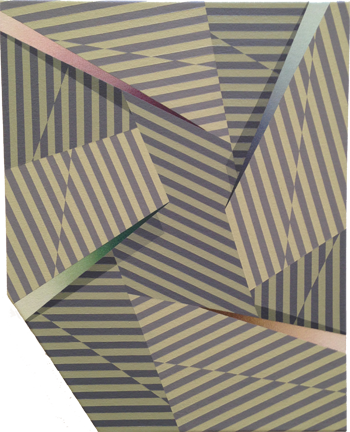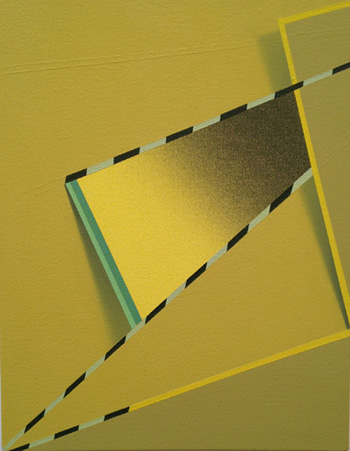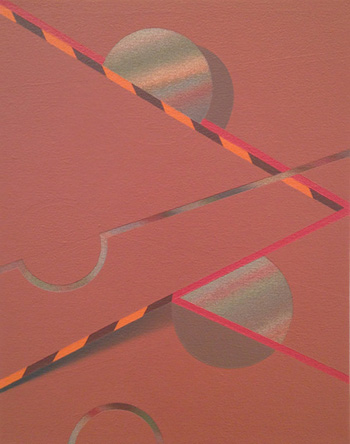Oijen, Wybe, Dele, Tomma Abts
patrick brennan
November 2014

Tomma Abts (at David Zwirner from September 10th through October 25th) dispenses with the quotation marks seemingly placed so often around a good amount of contemporary “painting” in a way that humbles. The exhibit of eight modestly scaled 48x38cm oil & acrylic canvasses and seven color pencil drawings on paper seemed unprepossessing enough until I realized that there’s a lot more going on than I even suspected I knew.
Her work bears witness contradicting that “end of painting” that’s been so zealously advocated over the past several decades while calling into question the common theoretical assumption of linear, Eurogenetic models of art history. For example, when Dave Flexingbergstein of Jism Magazine once asked Lester Bowie, “Is jazz dead?” Bowie’s reply was that “It depends on what you know.”
First glances hinted at trompe l’oeil takes on the potential vocabularies of Kandinsky, or Klee, or Af Klint, with perhaps a feint of a wink toward Stella, but it turned immediately clear that this is an artist who has hard earned a very personal language through the pursuit of her own investigations.
It just might be that history’s metaphorical “arrow of time” fleets along more than a single dimension’s track. It may bob, weave, lope, linger and loop. Homeostasis, and its reciprocal fluctuations, might better describe initiatives and developments among artists than an irreversible second law of thermodynamics. That historical firewall called “Modernism” may turn out to be no more than an ad hoc, arbitrary category, and “abstract” as perceptual region and language may be even less easily pigeonholed.
Abts’ pieces are ferociously inventive, but this isn’t something worn on the sleeve. They’re not exhibitionistic efforts conspicuously dressed to impress, but rather, self assured, potently soft spoken, unpretentious, no nonsense events. I thought at first that they might have been somewhat more effective had they been painted larger, but then I recognized the exacting appropriateness of their scale to a closely tuned bandwidth of intimacy relative to the size of a viewer.
 Likewise, I was a bit wary initially of their apparent fastidiousness (which is sometimes a mannerism for its own sake that accomplishes a popular fashion statement among some contemporary art), but I soon saw that these instances actively traced the chisel of clarification; and there are enough unapologetically painted over areas not only to confirm, but to reconfirm that.
Likewise, I was a bit wary initially of their apparent fastidiousness (which is sometimes a mannerism for its own sake that accomplishes a popular fashion statement among some contemporary art), but I soon saw that these instances actively traced the chisel of clarification; and there are enough unapologetically painted over areas not only to confirm, but to reconfirm that.
While Minimalism, among some other contemporary examples, has often procedurally segmented invention off from execution (as does Euroclassically organized music), it looks here as if Abts would rather not play smarter than a painting in quite that way. What I see resembles more what Klee once described as “taking a line for a walk.” And among these works, there are plenty of lines, quite a few of them flocking in various fields of parallel motion. I can see her playing with reflection and symmetry at times but without consenting to any predetermined regularity. Quite a bit of the time, that regularity is often offset, counterstated or subtly undone.
She also welcomes the ambiguities of spatial illusionism, even alluding to shadow in places, but the spaces and volumes implied orient toward a discontinuous, pluralistic, non-homogeneous dimensionality: “impossible” in a way that vaguely recall some of M.C. Escher’s graphic demonstrations of the internal contradictions of two dimensional depiction (this shows up especially among the drawings). However, Abts’ constructions aren’t at all corny like Escher’s, nor is her compositional incorporation of trompe l’oeil sensations cute. She implies multiple interpretations of visual movement to calibrate fluctuating tensions that don’t ever resolve, but remain potential: a sort of spatio-tactile surrealism.
Tensile conditions unfold here in narrative terms as well as visually. The internal variability and irregularity of these pieces trace the biographies of their having been composed and discovered within a relationship of mutual reciprocity with the artist. Archaeologically, one may encounter here something akin to distinctive “thought forms” — the shapes of consideration, comparison and integration, a way of moving though that particular situation, a drama of sorts that may be transposed or tried on for size. Yet these paintings and drawings don’t depict, illustrate or “represent” such experiences. They present. They unfold themselves rather than standing for something else or re-presenting. The viewer can discover and work out whatever moves for oneself.
 All of which reminds me of Morse Peckham’s suggestion that artworks function as accumulated deposits of behavior (or of generative actions) that then may occasion still further activity and engagement. What I like about his interpretation is that it allows artistic interaction to be recognized as a network of relationships, of actions, in contrast with more necrophilic attachments to objects, artifacts, styles, posturings or merchandise — art as a doing by all involved, not only as a thing production for spectators.
All of which reminds me of Morse Peckham’s suggestion that artworks function as accumulated deposits of behavior (or of generative actions) that then may occasion still further activity and engagement. What I like about his interpretation is that it allows artistic interaction to be recognized as a network of relationships, of actions, in contrast with more necrophilic attachments to objects, artifacts, styles, posturings or merchandise — art as a doing by all involved, not only as a thing production for spectators.
Abts’ paintings don’t behave like passive objects either, but as densely packed time release agents that evidence a process of their having been composed, through negative capability, from the inside out. This is why, for all their internal coherence, they seem to have formed themselves almost transrationally, a way that may include ratio but cumulatively reaches beyond the scope of any familiar one. Each whole work doesn’t “add up” arithmetically, but makes sense in a way that evades any single why, which is part of what contributes to the life they exude. Often, I tend to change around in my imagination what I see in front of me, to consider alternatives. But, in this case, these fascinate so eloquently that I’m happy to go with what they’ve got.
It’s within these circumstances wherein an artist responds directly and continuously to the unforeseen, (to what in Portuguese is pronounced imprevisto — the conditions in response to which one improvises) that Tomma Abts also most vividly unfurls her own distinctive virtuosity with color, shape, line, decision and coordination. It’s not for nuthin that Albert Murray described the on the spot reciprocity of improvisation as the ultimate human (i.e. heroic) endowment.
